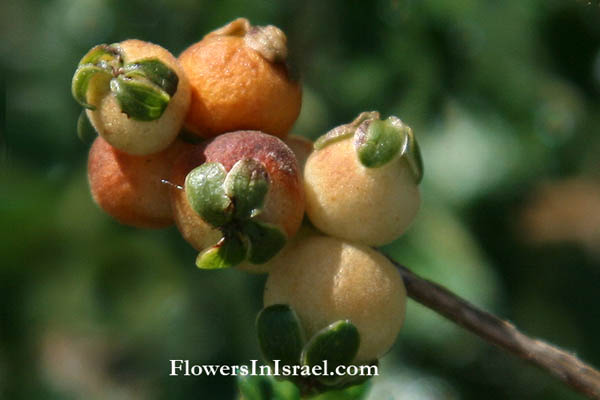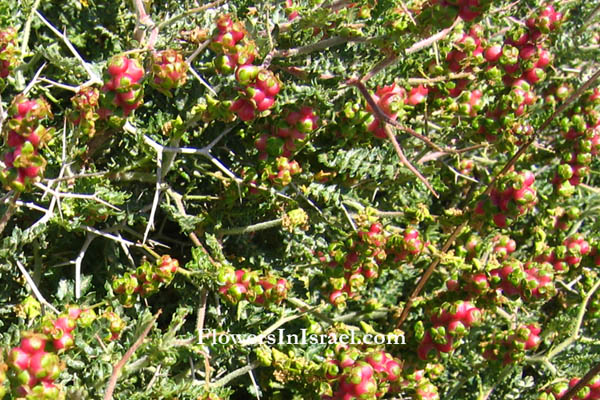Sarcopoterium spinosum, Poterium spinosum,
Thorny burnet, Pricky Burnet, Brushwood,
Hebrew: סירה קוצנית, Arabic: نتش بلان
|
|
| Scientific name: |
| Sarcopoterium spinosum (L.) Spach. |
| Synonym name: |
| Poterium spinosum L. |
| Common name: |
| Thorny burnet, Pricky Burnet, Brushwood |
| Hebrew name: |
| סירה קוצנית |
| Arabic name: |
| ( نتش (بلان |
| Plant Family: |
| Rosaceae, ורדיים |
|
|
| Life form: |
| Chamaephyte, semi-shrub |
| Spinescence: |
| Stems |
| Stems: |
| Up to 60cm; much-branched with wooly hairy shoots; lateral branches forming leaf-less spines |
| Leaves: |
| Alternate, leaves with 9-15 small, ovate, hairy leaflets |
| Inflorescence: |
| Green flowers in spikes to 3cm, globose or oblong |
| Flowers: |
| Upper flowers female, the lower male |
| Fruits / pods: |
| Fruit of 2 carpels enclosed in a berry-like structure, which becomes red and fleshy |
| Flowering Period: |
| February, March, April |
| Habitat: |
| Batha, Phrygana |
| Distribution: |
| Mediterranean Woodlands and Shrublands, Semi-steppe shrublands, Shrub-steppes, Deserts and extreme deserts, Montane vegetation of Mt. Hermon |
| Chorotype: |
| Mediterranean |
| Summer shedding: |
| Perennating |

Derivation of the botanical name:
Sarcopoterium, sarx, σαρξ, ρκοϛ flesh; Greek poterion a drinking cup, a goblet, a cup; Latin poterium and poterion.
spinosum, spiny.
The Hebrew name: סירה, sira of uncertain origin; perhaps from Aramaic: סירא, sira, or sir, thorn.
- The standard author abbreviation L. is used to indicate Carl Linnaeus (1707 – 1778), a Swedish botanist, physician, and zoologist, the father of modern taxonomy.
- The standard author abbreviation Spach is used to indicate Édouard Spach (1801 – 1879), a French botanist.
See the list of Medicinal herbs in Israel, the parts used and their medical uses to treat various diseases.
Lytton John Musselman, in his book "Plants of the Bible and the Quran", suggests Sarcopoterium spinosum to be the plant used for the crown of thorns placed on Jesus' head. Sarcopoterium spinosum has thorns up to 4 inches long. It is a flexible plant that would be easy to weave into a crown.
Sapoterium spinosum, Arabic ballan, which covers countless acres of bare hillside, was used all over Israel for ovens (Ecclesiastes 7:6) and lime-kilns. Before kindling one of these latter the fellahin gather enormous piles of this plant-carried on their heads in masses much larger than the bearers-around the kiln mouth.
Thorns are usually woody plants, such as Acacia, Lycium, Ononis, Prosopis, Rubus, Sarcopoterium, while thistles are herbaceous, such as Centaurea, Notobasis, Silybum.
Bible Resources:
- Hosea 2:6
Therefore I will block her path with thornbushes;
I will wall her in so that she cannot find her way.
- Ecclesiastes 7:6
Like the crackling of thorns under the pot,
so is the laughter of fools.
This too is meaningless.
|

